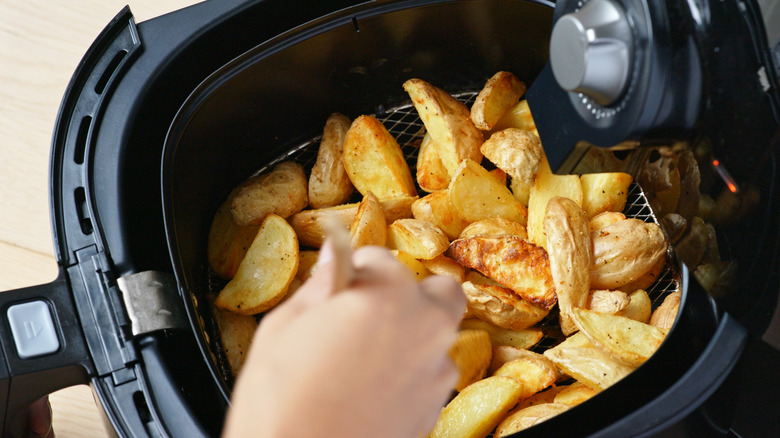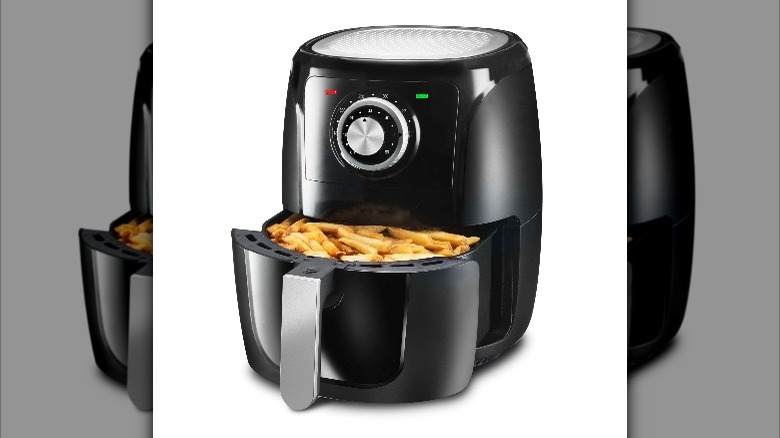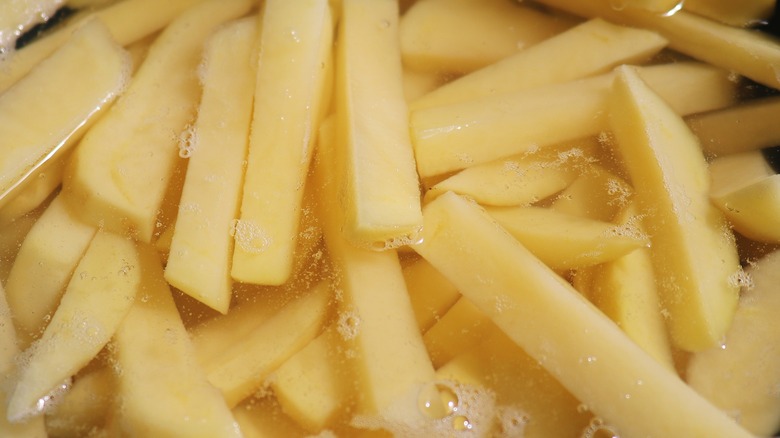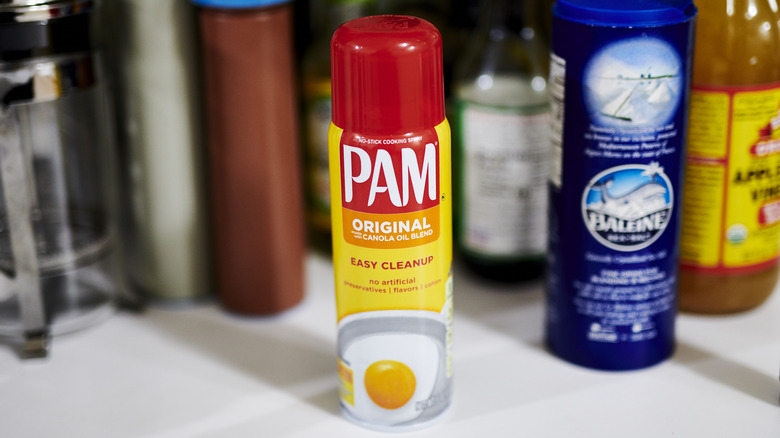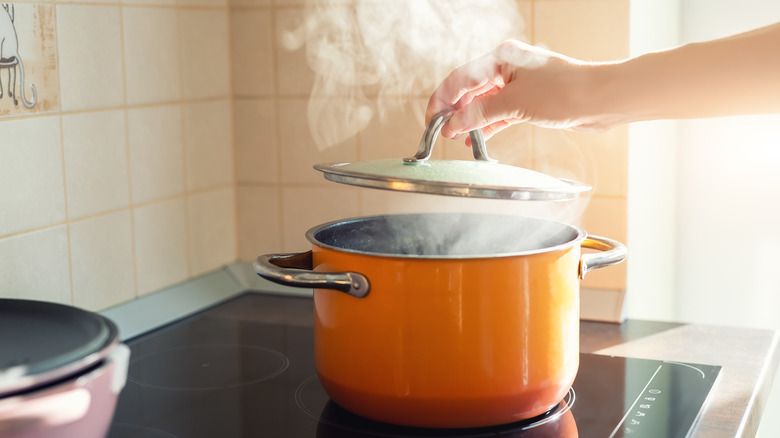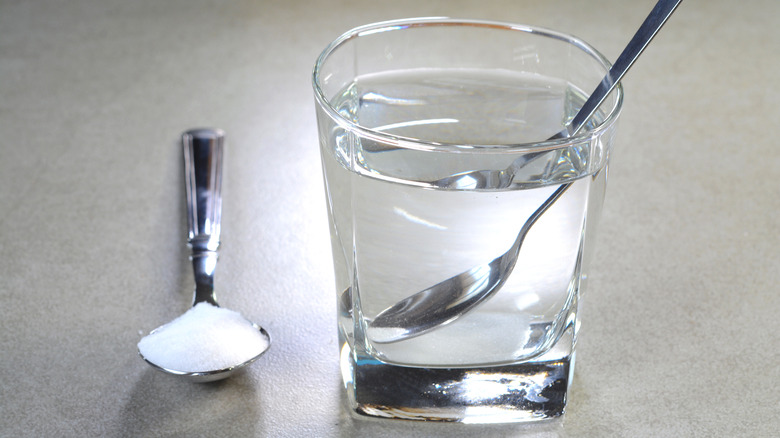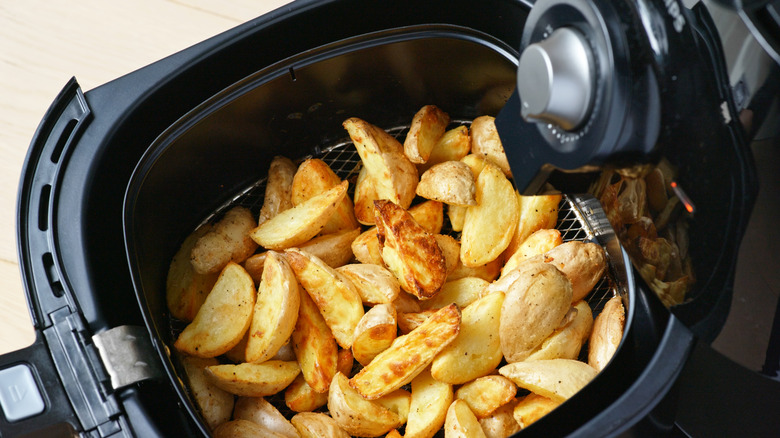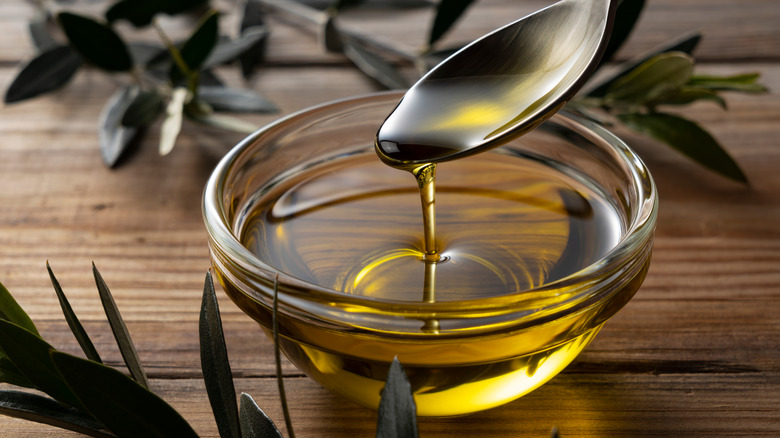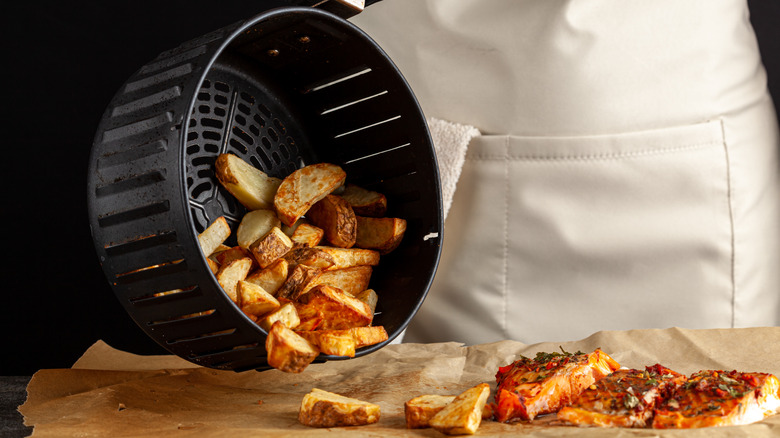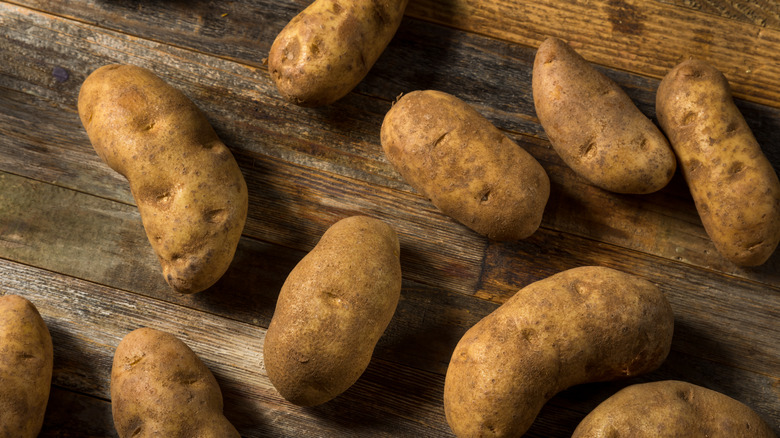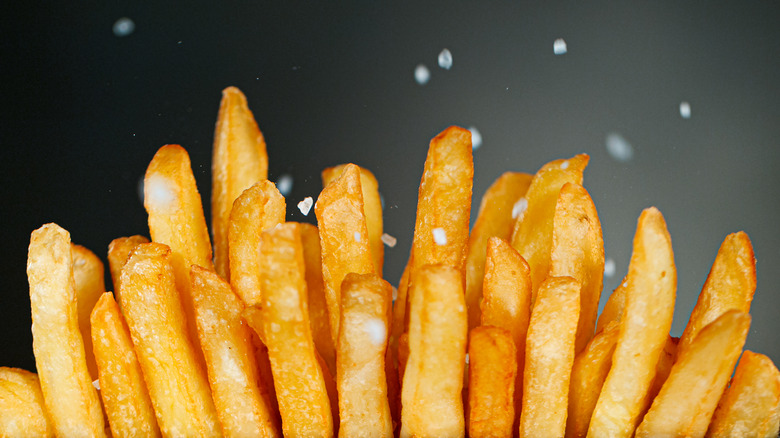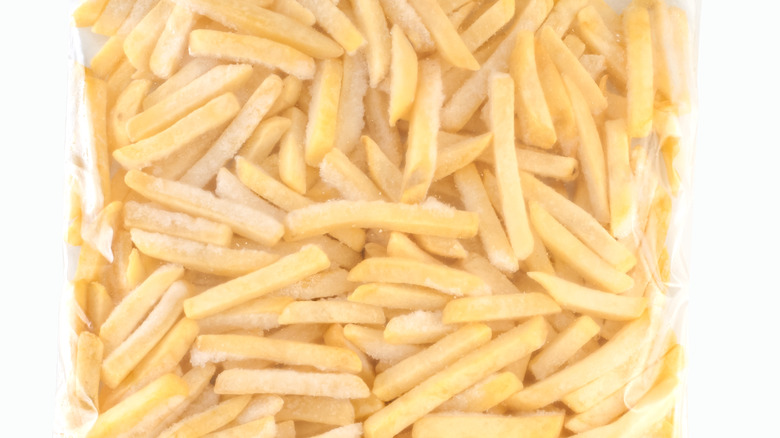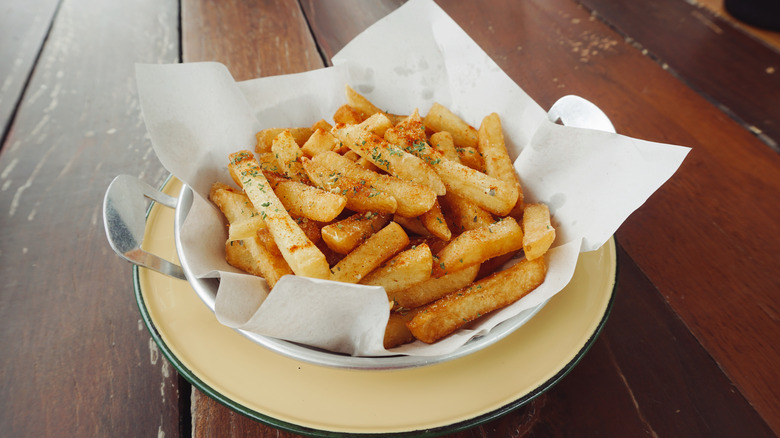Mistakes Everyone Makes When Cooking Fries In An Air Fryer
A tale as old as time itself, french fries have been a tried and true comfort food for generations. Whether you like 'em plain or loaded up with mayo, ketchup, and cheese, the glorious potato fries are the perfect companion to your good ol' American cheeseburger or classic fish 'n' chips. Crunchy on the outside, soft on the inside, fries will likely rule our hearts forever. As per the South Florida Reporter, Americans scarf down nearly 30 pounds of french fries annually.
Though some of us would be glad to eat fries with every meal, there have been a number of studies that show they don't exactly help those of us trying manage cholesterol and aren't exactly packed with nutrients. Looking for an alternative that doesn't involve ruling out fries entirely but uses less oil? Pull out your air fryer. As Women's Health notes, air-fried french fries have less than 150 calories per serving and don't need that much oil.
If you believe tossing simply potato sticks together with a dash of salt and a drizzle of oil is all there is to air-fried fries, think again. There's a little more to cooking fries in an air fryer. Let's dig into a few common mistakes folks make while making air-fried fries and what you can do instead to ensure a perfect hot pile of golden crispy fries every single time.
Forgetting to preheat your air fryer
When it comes to cooking anything literally, the simple act of preheating your air fryer can transform you from a rookie with a recipe to a professional home chef. Some air fryers, like the Philip air fryer reviewed here, don't call for preheating. However, you might still consider doing it, especially if your food always looks like a soggy, disappointing mess. Imagine Cinderella transforming from an indentured servant to a princess with a mere flick of a magic wand. Well, that's how magical preheating your air fryer can be, too.
An exaggeration? No way. Preheating your device will prepare your fries much quicker, and they will have that restaurant-quality crisp and crunch factor. A user on Reddit notes that using an air fryer is similar to using an oven in that you're going to want to make sure you make time for the preheat part. Some recipes might not demand a preheat, but you're better off preheating the air fryer anyway. Some foods, like pastries and thick raw meat, are better without preheating, though. Fries, however, deserve a preheat to get an audible crunch when you bite into the salty goodness.
When it comes to preheating your device, there's no rocket science attached. Read your air fryer manual to learn exactly how to preheat your device. Some models come equipped with a preheat function. If your air fryer does not have this feature, simply set the temperature at 380 degrees Fahrenheit for 12 to 15 minutes, and you're golden.
Not letting your potatoes soak first
Spoiler alert: Skipping this step results in a culinary disaster: sad, soggy fries devoid of flavor. Often, folks zip right on past soaking the potatoes and wonder what went wrong. Don't frown at the messy clump of fries. Nothing you can do about it now. However, the next time you want to cook fries in an air fryer, whip out a bowl of cold water. Once you've cut up your fries to the desired length, put them in the bowl. You can even add a few cubes of ice to it.
According to Sebastian Register, a home chef and owner of the YouTube channel Regester For Dinner, you should let the fries soak for about an hour to get that coveted crisp. Soaking the potatoes in cold water releases starch and gives your fries that crispy layer.
Food Crumbles notes that you'll eventually see the water becoming cloudy and murky, which is the excess and unwanted starch. Call it the bane of gourmet's existence. Before tossing these soaked fries into the air fryer, rinse them properly and pat them dry with a towel to soak up all the moisture.
Using a cooking spray
Cooking spray is such a neat and handy kitchen tool. So why not use it in your air fryer and save yourself from the hassle of scraping and washing, right? Wrong. While to err is human, the mistake of using a cooking spray in an air fryer is a disaster of epic proportions. And here's why.
You can use cooking oils in an air fryer, no biggie. Conversely, cooking sprays tend to damage the surface of the air fryer basket, per Kitchen Snitch. These baskets have a non-stick coating that tends to chip away when they come into contact with harsh chemicals. Most aerosol sprays, like Pam, have an ingredient called lecithin — a surfactant with emulsifying properties. As this substance comes into contact with Teflon, the result is a stubborn sticky buildup that eventually damages the surface of the basket, ruining the quality of your food.
Now imagine your fries are simmering in the heat, turning from pale yellow to a gorgeous golden brown, just how you like it. But when you pull out the drawer, you find dark bits of Teflon sticking to your fries. So, the bottom line is if you don't want to render your fries inedible, stop using store-bought cooking sprays. If you still prefer the ease of using a cooking spray, you can simply use an oil sprayer.
Not blanching the potato sticks
To blanch or not to blanch, that is never the question. Because for perfection, you always need to blanch your potatoes. This is especially true if you want your comfort food to be evenly cooked and your burger companion to have that incredibly textured layer of crunch. As a chef explained on Quora, "Blanching potatoes gelatinizes the starch on the exterior of the potatoes and draws out moisture. Both of those actions will result in crispiness."
As per the Blue Jean Chef, blanching your potatoes is easy. Simply peel and cut your potatoes while the water boils. Add salt to it, and place the potato sticks in the boiling water. Let it simmer for around four minutes, and then take them out. Make sure to pat them dry.
The magic that works here is that blanching removes all the moisture from the potatoes. And once you give them an excellent cold water soak, the cells in the potato shrink up, allowing them to crisp up more quickly. To quote the "Bill Nye the Science Guy" theme song, "Science rules."
Not using saltwater for the soaking process
While regular water works fine, using salt water for the soaking process ensures better and crispier results. Remember seventh grade science? More specifically, something called osmosis? Well, that's what's happening here. According to Boss The Kitchen, soaking peeled and cut potatoes in cold salt draws the starch, and moisture is drawn towards the area with higher salt concentration. Ergo the starch moves from the potatoes and into the salt water, leaving the potatoes in their very best form.
Interestingly, soaking your potatoes in salt water is also pretty healthy. As per the Journal of Agriculture and Food Chemistry, salt water removes a chemical, acrylamide, which is activated when starch comes into contact with a higher temperature. As noted by the National Cancer Institute, this substance is known to increase the risk of developing various forms of cancer. So it's best to take it out of the equation entirely.
Make sure to use cold water and soak them for around 15 minutes to 24 hours. The longer you soak, the better the results. However, if you're in a hurry, there's no harm in cutting down your soaking time.
Overcrowding your basket
It's air frying 101: You should never overcrowd your air fryer basket with food. If not culinary etiquette, it's common sense that overcrowding the basket will lead to multiple problems.
Cindy Gordon, a recipe developer and founder of Air Fryer Eats, explains in an episode on her YouTube channel that since air fryers act like convection ovens, the air circulates the food. This is precisely why the food cooks so quickly. So, if you overcrowd your air fryer basket, the air won't circulate properly, and this will result in inconsistent fry texture. Since the air won't have enough room to spread, the fries in the middle of the basket will only get steamed. Some won't be cooked, some won't be crisp, and some won't be cooked nor crispy.
As Cooking Light puts it, as tempting as it might be to stuff as many fries as possible in the air fryer to ostensibly speed up the process, it's a bad idea. Ensure only enough fries are in the basket to leave ample room for air circulation. You can cook your fries in batches or buy a bigger air fryer.
Not greasing your air fryer basket
While most folks know air frying is a far healthier option, they might overlook the fact that it still consumes oil. Sure, the amount of oil used, as opposed to pan-frying, is way less, but greasing your air fryer basket is a must. Otherwise, the fries won't achieve a good crispiness. Rather, they will turn out relatively dry and soggy.
Air Cookers recommends using oils with a higher smoke point, including grape seed, avocado, and olive oil. Toss a tablespoon of oil with your fries with salt and some seasoning.
You will also need to grease the bottom of the air fryer basket so the fries don't stick to it. As mentioned earlier, avoid using a cooking spray, as it can harm your air fryer basket. As Tanya Harris of My Forking Life notes, grease the basket by rubbing or spraying oil on the grates to ensure the food won't stick. Next, place the fries side by side, and remember not to stack them.
Not shaking your basket
Shake it till you make it. Well, make a beautiful pile of golden, crispy fries, that is.
Shaking the air fryer basket is crucial, especially if you're working with smaller foods like french fries, chicken wings, or chopped vegetables. You're probably thinking, "Won't shaking let the heat escape?" Sure. However, as Kitchen Snitches notes, some air fryers pause once you get the basket out to shake — but do not worry. Once you place the basket back in, the air fryer should kick back up and start cooking at the same temperature again.
While it's not exactly the same as giving the basket a good jostle, you can always use a pair of silicon tongs to flip your fries. This ensures your fries are evenly cooked from all sides, rather than letting it crisp up unevenly. Tasting Table offers an effective way to shake things up in the air fryer. Take the handle, pull out the basket and shake it. When making fries, shaking once is enough.
Using the wrong potatoes
You may be just making fries with any kind of potato you have on hand, but it turns out there are certain types of potatoes that are the best of the best for making french fries. And not just any fries: super-duper crispy, nostalgia-inducing salty fries. To make these fries, you must use russet potatoes, particularly the Russet Burbank kind. These potatoes are higher in starch and low in moisture content, making them the perfect ingredient to make heaven on a plate (via Kitchen Appliance HQ). However, according to Foods Guy, you can also use Yukon Gold and Maris Piper potatoes.
A russet potato is recognizable by its characteristic oblong shape, brown skin, and starchy white insides that fluff up nicely when fried, per eHow. The skin on a russet potato is also harder than that of a regular potato, making it perfect for making fries with skin intact, so your crunch will be intensified. Apart from choosing russets, you should get a large-sized spud, since they are easy to cut and make for a large, finger-sized fry. Russets cook up beautifully in the air fryer and more quickly than other potatoes, too. A Reddit user claims that russets are basically a "requirement" for making restaurant-quality fries.
Adding salt after cooking
Sprinkling salt over a steaming plate of freshly made fries seems like the right thing to do. You've likely been doing this for as long as you've been making fries, and nothing terrible has happened ... yet. So why is it a mistake if you're making fries in an air fryer?
Adding salt to your food after they've been deep-fried is a must, but for oven-baked or air-fried fries, it's another story entirely. What you need to do instead is coat the raw fries in olive oil using an oil spray and toss them. Then, add salt (and any other seasonings — we recommend a blend that includes ground cumin, chili powder, and garlic powder) and toss once again to mix it up for good measure. Of course, you can tweak the seasoning blend as per your taste. If you've left the skin on for your russet potatoes, you'll find that steam and oil will work wonders in absorbing the salt and any other flavors.
A Quora user suggests sprinkling seasoning on fries when loaded in the air fryer and then putting the basket in the air fryer to crisp 'em up. One salty plate of golden fries comin' right up! Per Boss The Kitchen, it's best to use fine salt or ground salt rather than large coarse salt flakes. This will allow the salt flavor to be fully absorbed by the potato, enhancing the taste. As the fries simmer in the heat, the oil will start to cook up the salt, melting right into the surface.
Thawing frozen french fries
Thawing frozen foods before cooking them seems like common sense. Whether it's frozen chicken or vegetables, shouldn't you be thawing and defrosting them once they're out of the freezer? While that's the case for a lot of frozen food, it doesn't work for fries when making them in an air fryer.
To save yourself from a soggy mess of fries that are far too limp to even be considered being served, you're better off tossing frozen fries in the air fryer directly from the freezer. In this case, preheating your air fryer is a literal must. The air fryer should be heated beforehand, so once the fries enter the realm of the "healthy cooking vessel," they immediately start to heat up. You'll have the best air fryer french fries, gorgeously golden on the outside while fluffy and soft on the inside.
Plated Cravings says that once you get the frozen fries out of the packet, you should season them and toss them in the preheated air fryer. Stuff no more than three-quarters full with fries, and bake. After every 5 minutes, shake the basket, so the fries cook evenly. The fries will be done in about 15 minutes. As suggested by a Reddit user, you can make tasty frozen fries even quicker by preheating the air fryer for up to 7 minutes and directly placing the frozen fries in the basket. Next, you can season and proceed to cook at 400 F for 15 minutes — and that's it!
Leaving the fries on a paper towel
We have all seen our mothers grab a bunch of paper towels and lay them on a tray when making fries. The steaming-hot fries with oil dripping from the strainer spoon are gently tossed onto the prepared tray so that the paper towel can absorb the excess oil. You've probably been doing this too; it's a rite of passage. And why wouldn't you? No one wants to be eating oil-laden fries, right? But what if we were to tell you that there's another, better way to do this? (Insert audible gasp). Yep, we're here to tell you that a cooling rack gets the job done — without making a mess.
Kosher.com says to lay a tin foil sheet on the counter and place the cooling rack above it, so the oil spill is easily cleaned up. Awesome, right? What's more is that we've found that paper towels often stick to the fries, the oil working like glue in this case. As the fries start to cool down, the paper gets stuck, rendering them inedible and gross. No one wants to eat paper!
A Reddit user suggests putting fried items fresh from the hot oil bath onto the cooling rack so the air can hit them up from all sides — even under the fries — to crisp them up nicely and thoroughly. Paper towels, on the other hand, turn fries soggy and limp.
